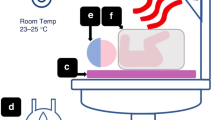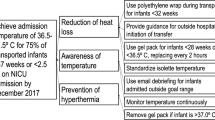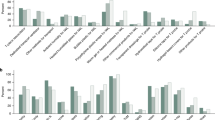Abstract
OBJECTIVE:
Preterm infants are prone to hypothermia immediately following birth. Among other factors, excessive evaporative heat loss and the relatively cool ambient temperature of the delivery room may be important contributors. Most infants <29 weeks gestation had temperatures <36.4°C on admission to our neonatal unit (NICU). Therefore we conducted a randomized, controlled trial to evaluate the effect of placing these infants in polyurethane bags in the delivery room to prevent heat loss and reduce the occurrence of hypothermia on admission to the NICU.
METHODS:
After parental consent was obtained, infants expected to be <29 weeks gestation were randomized to intervention or control groups just prior to their birth. Infants randomized to the intervention group were placed in polyurethane bags up to their necks immediately after delivery before being dried. They were then resuscitated per NRP guidelines, covered with warm blankets, and transported to the NICU, where the bags were removed and rectal temperatures were recorded. Control infants were resuscitated, covered with warm blankets, and transported without being placed in polyurethane bags. Delivery room temperatures were recorded so this potentially confounding variable could be assessed.
RESULTS:
Intervention patients were less likely than control patients to have temperature < 36.4°C on admission , 44 vs 70% (p<0.01) and the intervention group had a higher mean admission temperature, 36.5°C vs 36.0°C (p<0.003). This effect remained significant (p<0.0001) when delivery room temperature was controlled in analysis. Warmer delivery room temperatures (≥26°C) were associated with higher admission temperatures in both intervention and control infants, but only the subgroup of intervention patients born in warmer delivery rooms had a mean admission temperature >36.4°C.
CONCLUSIONS:
Placing infants <29 weeks gestation in polyurethane bags in the delivery room reduced the occurrence of hypothermia and increased their NICU admission temperatures. Maintaining warmer delivery rooms helped but was insufficient in preventing hypothermia in most of these vulnerable patients without the adjunctive use of the polyurethane bags.
This is a preview of subscription content, access via your institution
Access options
Subscribe to this journal
Receive 12 print issues and online access
$259.00 per year
only $21.58 per issue
Buy this article
- Purchase on Springer Link
- Instant access to full article PDF
Prices may be subject to local taxes which are calculated during checkout


Similar content being viewed by others
References
Lyon AJ, Pikaar ME, Badger P, McIntosh N . Temperature control in very low birthweight infants during first five days of life. Arch Dis Childhood 1997;76:F47–F50.
Hey EN, Katz G, O'Connell B . The total thermal insulation of the new-born baby. J Physiol 1970;207:683–698.
Silverman WA, Fertig JW, Berger A . The influence of the thermal environment upon the survival of newly born premature infants. Pediatrics 1958;22:876–886.
Buetow KC, Klein SW . Effect of maintenance of “normal” skin temperature on survival of infants of low birth weight. Pediatrics 1964;34:163–170.
Day RL, Caliguiri L, Kamenski C, Ehrlich F . Body temperature and survival of premature infants. Pediatrics 1964;34:171–181.
American Academy of Pediatrics & American College of Obstetrics and Gynecologists. Guidelines For Perinatal Care. 2nd edn. Elk Grove Village, IL: American Academy of Pediatrics; 1988.
Sauer PJ, Dane HJ, Visser HK . New standards for neutral thermal environment of healthy very low birthweight infants in week one of life. Arch Dis Childhood 1984;59:18–22.
Wheldon A, Hull D . Incubation of very immature infants. Arch Dis Childhood 1983;58:504–508.
Kattwinkel J . Textbook of Neonatal Resuscitation. 4th edn. United States of America:American Academy of Pediatrics and American Heart Association; 2000.
Vohra S, Frent G, Campbell V, Abbott M, Whyte R . Effect of polyethylene occlusive skin wrapping on heat loss in very low birth weight infants at delivery: A randomized trial. J Pediatr 1999;134:547–551.
Hazan J, Maag U, Chessex P . Association between hypothermia and mortality rate of premature infants-revisited. Am J Obstet Gynecol 1991;164:111–112.
Loughead MK, Loughead JL, Reinhart MJ . Incidence and physiologic characteristics of hypothermia in the very low birth weight infant. Pediat Nursing 1997;23:11–15.
Bjorklund L, Hellstrom-Westas L . Reducing heat loss at birth in very preterm infants (letter). J Pediatr 2000;137:739–740.
Baumgart S, Engle WD, Fox WW, Polin RA . Effect of heat shielding on convective and evaporative heat losses and on radiant heat transfer in the premature infant. J Pediatr 1981;99:948–956.
Baumgart S . Reduction of oxygen consumption, insensible water loss, and radiant heat demand with use of plastic blanket for low-birth-weight infants under radiant warmers. Pediatrics 1984;74:1022–1028.
Besch NJ, Perlstein PH, Edwards NK, Keenan WJ, Sutherland JM . The transparent baby bag. New Eng J Med 1971;284:121–124.
Hammarlund K, Nilsson GE, Oberg PA, Sedin G . Transepidermal water loss in newborn infants: V. Evaporation from the skin and heat exchange during the first hours of life. Acta Paediatr Scand 1980;69:385–392.
Richardson D, Corcoran J, Escobar G, Lee S . SNAP-II and SNAPPE-II: Simplified newborn illness severity and mortality risk score. J Pediatr 2001;138:92–100.
Hammarlund K, Sedin G . Transepidermal water loss in newborn infants: III. relation to gestation age. Acta Paediatr Scand 1979;68:795–801.
Fanaroff A, Rand M, Wald M, Gruber H, Klaus M . Insensible water loss in low birth weight infants. Pediatrics 1972;50:236–245.
Wu P, Hodgman J . Insensible water loss in preterm infants: changes with postnatal development and non-ionizing radiant energy. Pediatrics 1974;54:704–712.
American Academy of Pediatrics & American College of Obstetrics and Gynecologists. Guidelines For Perinatal Care. 5th edn. Elk Grove Village, IL: American Academy of Pediatrics; 2000.
Acknowledgements
The authors would like to acknowledge the additional investigative team members, Carla Ahearn RNC, MSN, NNP and Marie Morton, RN. We would also like to acknowledge Diane Holditch-Davis, RN, PhD, and Alex Robertson, MD for their thoughtful review of the manuscript.
Author information
Authors and Affiliations
Corresponding author
Additional information
This research was partially supported by National Institute for Nursing Research T32 NR07091 Interventions to Prevent and Manage Chronic Illness.
Rights and permissions
About this article
Cite this article
Knobel, R., Wimmer, J. & Holbert, D. Heat Loss Prevention for Preterm Infants in the Delivery Room. J Perinatol 25, 304–308 (2005). https://doi.org/10.1038/sj.jp.7211289
Published:
Issue Date:
DOI: https://doi.org/10.1038/sj.jp.7211289
This article is cited by
-
Using polyethylene plastic bag to prevent moderate hypothermia during transport in very low birth weight infants: a randomized trial
Journal of Perinatology (2018)
-
Standard care with plastic bag or portable thermal nest to prevent hypothermia at birth: a three-armed randomized controlled trial
Journal of Perinatology (2018)
-
Initial Management of the Extremely Low-Birth-Weight Infant
Current Treatment Options in Pediatrics (2017)
-
The effect of coverings, including plastic bags and wraps, on mortality and morbidity in preterm and full-term neonates
Journal of Perinatology (2016)
-
The global burden of neonatal hypothermia: systematic review of a major challenge for newborn survival
BMC Medicine (2013)



